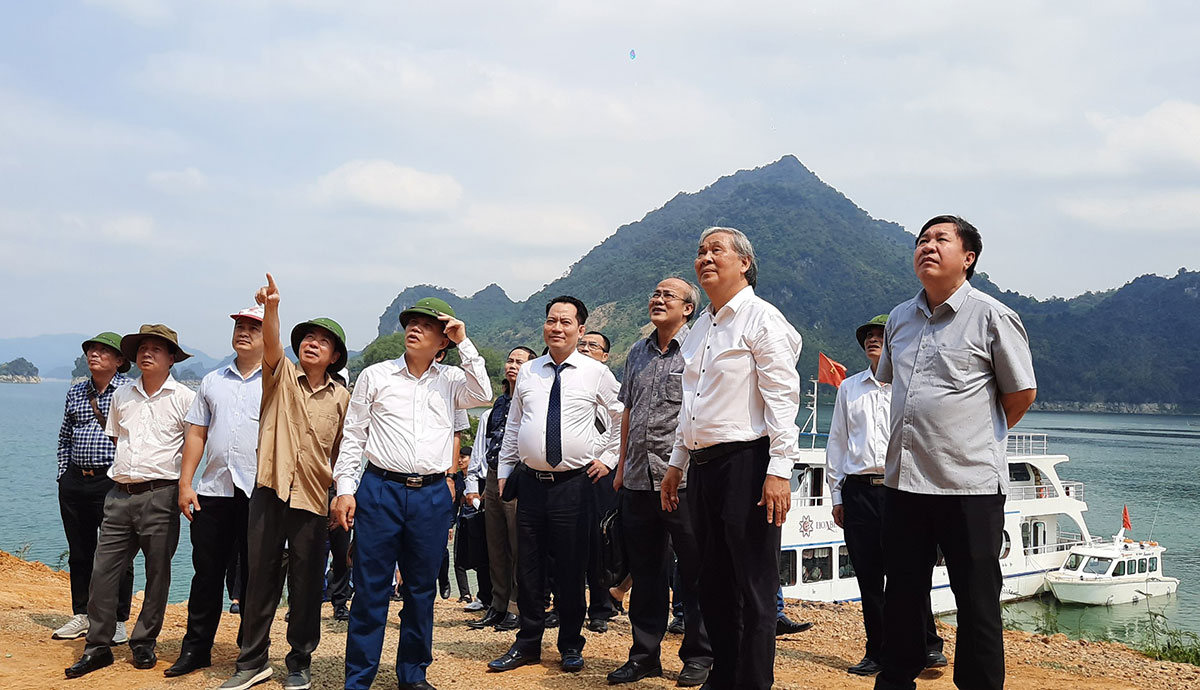
(HBO) – Coming to the countryside in Hoa Binh province, it is easy to see new vitality in each village and commune because the electricity - road - school - station system and key infrastructures are built spaciously and firmly. Paddy fields, mountains and forests stretch with creative and effective economic models.

Vice Secretary of the provincial Party Committee and Chairman of the provincial
People’s Committee Bui Van Khanh inspects projects in Hoa Binh lake.
The
new-style rural development campaign turned villages and communes into ideal
areas such as Ho 1 village. Over the past years, in order to mobilise the
involvement of the entire political system, the Chairman of the provincial
People’s Committee directed building an action plan for the effort and launched
an emulation drive called "Hoa Binh province joins hands to build new-style
rural areas”. In response to the 2020 campaign, the province mobilised about
85,000 workdays, allocated some 9,500 sq.m of land, raised over 20 billion VND
in cash and in kind worth more than 272 billion VND.
According
to the provincial People’s Committee, more than 16.2 trillion VND were raised
for the effort during the 2016-2020 period. The province issued a number of
mechanisms and policies to raise funds for communes to complete the building of
new-style rural areas.
As a
result, socio-economic infrastructure were upgraded in accordance with the
master plan, connecting with the provincial and regional socio-economic
infrastructure.
A
highlight was the effort of the district-level People’s Committees to step up
the restructuring of the agriculture sector to improve added value and fuel
sustainable development in combination with new rural development.
By the
end of 2020, the province had 12 communes meeting enhanced criteria for
new-style rural areas, 46 new-style model residential areas, 151 model gardens;
58 out of 131 communes achieving 19 criteria for new rural development. On
average, each commune met 15.31 criteria and there was not any commune meeting
below 10 criteria./.
Hoa Binh province is undergoing a dynamic transformation amid Vietnam’s national digital transition. Building on Poliburo’s Resolution No. 57-NQ/TW on breakthroughs in science, technology, innovation, and national digital transformation, the province has rolled out a wide range of practical action plans. A standout initiative is the "Digital Literacy for All” movement, an effort to ensure that no one is left behind in the digital era.
Hoa Binh province is undergoing a dynamic transformation in the wake of the national digital transformation movement. Building on Resolution No. 57-NQ/TW of the Politburo on breakthroughs in science, technology, innovation, and national digital transformation, the province has implemented a wide range of practical action plans. A standout initiative is the "Digital Literacy for All” movement ambitious effort to ensure that no one is left behind in the digital age.
With a spirit of unity and proactive problem-solving, the Party Committee, the government and the people of Dong Lai Commune (Tan Lac District) have made great strides in implementing the resolutions of the 24th Party Congress of the commune for the 2020 - 2025 term. Focusing on leadership and practical actions, the commune has brought the Party’s resolutions into daily life, creating strong impacts and pushing the local development forward.
Amid the nationwide push for digital transformation, young people in Hoa Binh Province are stepping up as dynamic pioneers, applying technology to enhance Youth Union operations and expand the reach of youth-led initiatives. Through creativity and adaptability, Youth Union organizations at all levels have introduced a series of practical solutions, contributing to modern governance and community development.
In recent years, An Nghia commune, located in Lac Son district, has stepped up administrative reform, focusing on improving the quality and efficiency of its single-window service unit for receiving and processing administrative procedures. These improvements have helped create favourable conditions for local residents and organisations to handle administrative procedures, contributing to the commune’s broader socio-economic development.
The Prime Minister-approved master plan to develop the multi-use value of forests ecosystems through 2030, with a vision to 2050, aims to improve the management and sustainable use of forest resources, create jobs, increase incomes, and improve the living standards of ethnic minorities, people in mountainous and remote areas, forest workers and those living near forests.



